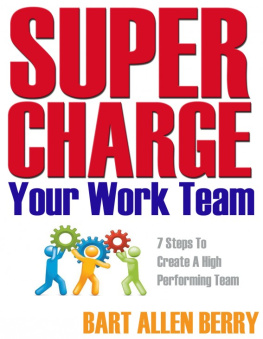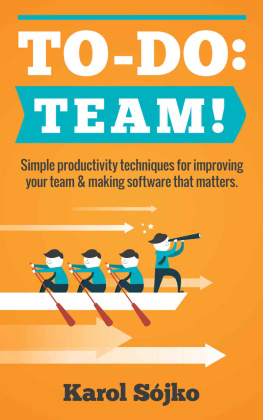SUPERCHARGE
YOUR WORK TEAM
Seven Steps To Create A High PerformingTeam
By Bart Allen Berry
Smashwords Edition
Copyright 2013 Bart Allen Berry
Discover Other Titles By Bart Allen Berry at:https://www.smashwords.com/profile/view/BartAllenBerry
This book or its parts may not be copied orreproduced without the permission of the author.
Table Of Contents
Introduction
All organizations, even the smallest, dependon teamwork for their success. A high performing team is not onlycapable of more but serves as an inspiration to others bydemonstrating whats possible when people work together well.
Creating a high performing team is astructured, proven process through which you can tap more of ateams potential to attain significant improvements in performanceand productivity. An additional benefit is the improvement in jobsatisfaction for all concerned.
Synergy might seems like an overused termin management science lingo, but there really is no better word todescribe the dynamic effect produced when:
- Barriers to teamwork are removed
- The work team defines a stronger identityfor themselves as a high performing team
- The work team learns more effective groupprocess skills and approaches
- Individuals mitigate their owndysfunctional team behaviors
- A strong commitment and plan is establishedby the team with 'buy-in' from each of its members
Does synergy sound like a lofty or evenimpossible goal? There is a systematic approach to buildinghigh-performing teams that will work for you even if youve triedteam training, team development or team building before.
Supercharge Your Work Team outlines thecritical steps needed to transform your low or average-functioningteams into high-performing, synergistic units that are recognizedfor results and widely acknowledged for their strong and positiveinfluence on the organization. This methodology is not onlyappropriate for low performers or teams with serious problems butalso for taking well-performing teams to even greater levels ofproductivity and team member satisfaction.
Who can benefit from this book?
Any work group
Training and HR Directors
Company Presidents and CEOs
Executive Teams
Sales Teams
Engineering Teams
Any functional work group whose members havean interest in working better together
Individual team members who want to be acatalyst for improvement on their own dysfunctional teams
SUPERCHARGE YOUR WORK TEAM Seven Steps To ACreate A High Performing Team is based on our work with over200,000 employees and managers over the past 28 years. The bestpractice approach described here has repeatedly validated itselfwith work groups from nearly every industry in six differentcountries.
Why Team Building Must Be A Priority
There is one simple answer to this question:Work groups without good teamwork cost the organization money.
Poor teamwork impacts the organizationsbottom line. Dysfunctional, underperforming and ineffective teamscreate inefficiency, waste, rework and mistakes. They can be thecause of low morale, they undermine worker commitment andinitiative, and can be a major cause of stress in theworkplace.
If poor teamwork is pervasive, it can rob anorganization of its competitive advantage and threaten its veryexistence.
Consider some of the ramifications of lowlevels of teamwork:
Excessive sick leave
Stress-related illnesses
Missed deadlines, quotas, or productiongoals
Poor quality of products and services
Conflict
Lack of communication within and betweendepartments
Customer dissatisfaction
Lost customers
Lack of creativity
Stifled initiative
Workplace sabotage (disgruntled employees whoerase vital computer files, etc.)
Work teams who never reach theirpotential
Retention problems resulting in the need forcostly recruitment and training of replacement workers
A negative atmosphere that turns away thebest talent
Upset workers who file expensive lawsuits
Lack of confidence and support formanagement
The list goes on.
The costs can escalate exponentially overtime if teamwork issues are not identified and corrected. Theseissues can jeopardize even a successful business in todayscompetitive marketplace. A comment you often hear about a companyon the ropes is They just cant get it together. Lack of teamworkcan almost always be identified as one of the central issues when acompany is floundering, identifying it as a symptom or a cause.
Investing In TeamsOne Of The BestInvestments Youll Ever Make
The major expense in most companies is not inequipment or materials but in human capital. While almost allcompanies spend profusely on maintenance and upgrades to keep theirexpensive systems and machinery operating at peak levels, only thebest organizations invest in their work teams in the same way.
Any organization is only as good as thepeople who work there. Investing in Team Development means toinvest in your human capital, to create an environment whereincreasingly more self-directed groups of talented individuals takepride in what they do, have a strong sense of identity and purpose,and excel in productivity because of the nature of how they worktogether. These teams give off positive energy that is contagiousacross the organization, are recognized and respected as leadersand can be counted on to deliver.
Consider any commodity industry where theproducts and services are mostly the same. Whether linoleumflooring, light bulbs or life insurance, the true differentiationbetween a successful company and an unsuccessful one is the oftenpeople. How employees work together can make the difference betweena motivated and energized enterprise, recognized for itsefficiency, focus and innovation and its competitor which isstaffed by clock punchers who are unempowered and motivated byfear.
Make no mistakethe latter organization willeventually lose its most talented workers- and often to that otherfirm with a better environment of teamwork.
Every Team Needs Maintenance
No matter what the organization or industry,it is statistically improbable that everyone in a given work groupwill get along with one another, and that there wont be problems,issues and relationship difficulties. Astute managers recognizethat every team can benefit from team building, skills developmentand support.
Training Cost And Time Considerations
The decision to invest in team development orteam building has been difficult for some organizations becausethey havent had a clear picture of the cost-benefit relationship.The benefits mentioned here, as well as the risks for not investingin team development, have not seemed tangible enough to justify theexpense of such a program on a quarter-by-quarter basis. Hereinlies the problem:
Any organization needs a complete process forteam development, not a hit-and-miss strategy. There are manyincomplete approaches to team development today. Consultants areusually willing to build a program around whatever the company iswilling to spend in time and money regardless of whether it isreally what the organization needs or whether it will producelasting results. Most training companies would never admit to this,of course, but let the buyer of training beware! While suchtrainers are well intended, there are dangers inherent infragmentary approaches to team development.
28 years of teamwork consulting and trainingreminds us that our challenge is always to get the client to committo a process that is actually going to achieve their desiredoutcome of creating high performance teams.
In todays downsized business environment,time is as much a factor as cost when making a commitment to teamdevelopment programs. In the 1980s, three to five-day team trainingprograms were the norm, and significant change could beaccomplished in that length of time. The time companies werewilling to invest became shorter in the 1990s until today the trendis toward one and two-day team programs, sometimes shrinking tohalf day or one to two hour segments. Such time restraints make itextremely difficult for a teamwork trainer to achieve the desiredresults. Shorter programs like these miss the mark and create a badreputation for the teamwork consulting industry. Such ineffectiveteam development models set unrealistic expectations and give theentire concept a bad name with employees as well as trainingdecision makers.
Next page




